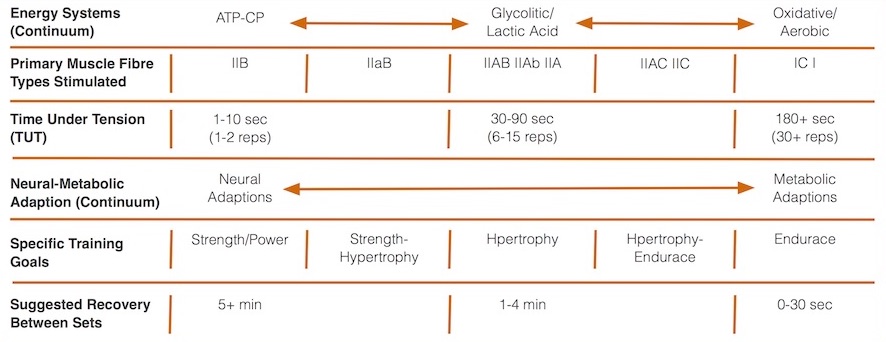The term Training Mode refers to the primary response or adaptions to the type of training being performed.
Generally the response obtained may primarily be neural or metabolic however adaptations from both the neural and metabolic continuum will occur.
Neural adaptations from (strength) training include:
1. Increased recruitment and synchronization of motor unit.
2. Increased activation of the contractile apparatus.
3. Decreased inhibition by the proactive mechanisms of the muscle.
4. Some possibility of increase in muscle cross-section.
Metabolic adaptations from (strength) training include:
1. Significant possibilities of increase in cross-sectional area of muscle (hypertrophy)
2. Increased density of mitochondria.
3. Increase vascularization of tissues
4. Increased capillarization.
5. Increase in aerobic enzymes and ATP
Both neural and metabolic training will improve intermuscular and intramuscular coordination.
A predominantly neural training method for one client may result in a primarily metabolic effect in another. Factors that may influence the primary adaptive response include:
1. Training age
2. Training history (including past training environment)
All training occurs at some point along the neural-metabolic continuum. Understanding where on this line the client needs to be and how to develop an exercise program to achieve this is critical.

The Neural-Metabolic Continuum in Training Adaptations

Summary of adaptations associated with the two training modes:
Neural Strength Training is associated with:
1. Increased strength from increased neural drive
2. Increased in relative strength
3. Improved size & function of type II (Fast twitch) muscle fibers
4. Recruitment of higher threshold motor units
Metabolic Strength Training is associated with:
1. Increased strength from increased size of muscle
2. Increase in absolute strength
3. Improved size & function of type I (slow twitch) muscle fibers
4. Recruitment of lower threshold motor units
Summary of variables associated with the two training modes:
Summary of training variables associated with the two training modes:
Neural Strength Training is associated with:
1. Higher loads of greater than 80% 1RM
2. Shorter time under tension of 20 seconds or less
3. Longer rest periods between sets of greater than 2 minutes
4. Lower reps of 6 reps or less (or time based repetitions)
Metabolic Strength Training is associated with:
1. Lower load of less than 80% 1RM
2. Longer time under tension of grater than 20 seconds up to 90 sec
3. Shorter rest periods between sets of 2 minutes or less
4. Higher reps of greater than 6 reps
The clients’ individual needs to be identified, taking in consideration all other factors and the annual plan should reflect these requirements dedicating more time specializing at the specific end of the continuum. This is what long term planning (periodization) is so importing when programming as allows a better understanding the type of training that should be performed to attain the needs and wants of the individual.
A classic example of this would be Olympic weightlifting and bodybuilding that are typically found at opposite ends of the neural-metabolic continuum.
 The Positioning on the Neural-Metabolic Continuum in Training Adaptations
The Positioning on the Neural-Metabolic Continuum in Training Adaptations
Specialize at the specific end of the continuum that is found to be dominant to obtain the individual needs. The includes both there annual and multi-year plan.
If the dominant training mode is found to be neural you should still always progress from metabolic to neural. The metabolic end of the continuum will allow time to develop the foundation necessary for more neural training.
If the training mode is found to be dominantly metabolic then consideration should be given to train from the far metabolic end towards the neural end of the metabolic ranges. There is also potential for progress fully into the neural end of the scale.
Even clients specializing at the highest levels at either end of the neural-metabolic continuum will benefit from spend at least a short period of time training non-specifically.
